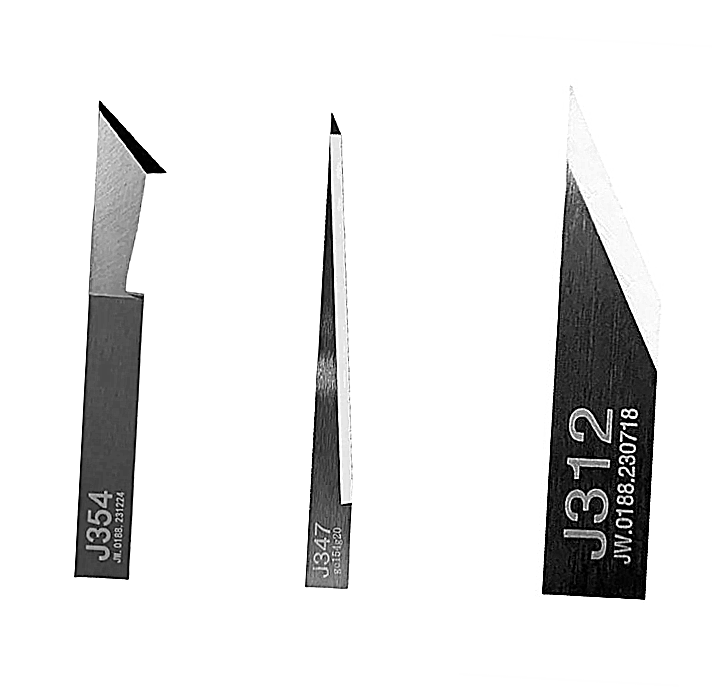How to Choose the Right Jwei Flatbed Digital / CNC Cutting Machine Knife Blade for Foam Materials
When selecting a Jwei flatbed digital or CNC cutting machine knife blade specifically for foam materials, consider the following key factors based on blade specifications, material compatibility, and cutting requirements:
1. Blade Type and Cutting Method
· Oscillating Knife Blades: Good for thicker and more rigid foam materials, providing precise and efficient cutting with vibration motion.
· Drag (Flat) Blades: Suitable for softer foam boards and similar materials, offering clean cuts with a flat dragging motion.
· Rotary Blades: Ideal for thin foam sheets and flexible materials, providing smooth cuts with a rotating motion.
2. Blade Specifications to Match Foam Cutting Needs
· Blade Thickness and Height: Thicker blades (e.g., 1.5mm thickness) with sufficient height (e.g., 50mm) allow deeper cuts into foam boards.
· Cutting Depth: Choose blades that support the maximum cutting depth required for your foam thickness. For example, the Jwei J354 flat drag blade supports up to 20mm cutting depth, suitable for foam boards.
· Cutting Angle: Blades with angles around 45° to 90° are common for foam cutting, providing sharp and clean edges without tearing.
3. Recommended Jwei Blades for Foam Materials
Thickness: 1.5mm
Cutting Angle: 45°/90°
Max Cutting Depth: 20mm
Suitable Materials: Foam board, PVC, corrugated plastic, paper, polyester fabric, tarpaulin
Features: High-strength tungsten steel, durable and precise cutting, compatible with flat drag cutting heads.
· Jwei J347 Long Knife Blade:
Size: 68x6.35x1mm
Angle: 85° / 5°
Max Cutting Depth: 35mm
Suitable for foam, carton, cardboard, honeycomb, plastic sheets, rubber
Ideal for thicker foam materials requiring deeper cuts.
· Jwei J354 Drag Blade (available on OYEA as well):
Designed for foam board cutting with high precision and durability.
4. Consider Cutting Thickness and Material Density
· For soft foam materials with thickness up to 20mm, the J354 flat drag blade is highly recommended.
· For thicker or denser foam, consider blades like J347 with greater cutting depth capacity.
· For thin foam or flexible foam sheets, rotary blades or oscillating blades with smaller cutting depths may be more suitable.
5. Compatibility with Machine and Cutting Head
· Ensure the blade type matches the cutting head on your Jwei flatbed cutter (e.g., flat drag blade for flat drag cutting heads).
· Verify blade mounting specifications such as thickness and width to fit your cutter model.
Summary Table for Foam Cutting Blades
|
Blade Model |
Type |
Thickness |
Cutting Angle |
Max Cutting Depth |
Suitable Foam Type |
Notes |
|
J354 |
Flat Drag |
1.5 mm |
45°/90° |
20 mm |
Foam board, soft foam |
Tungsten steel, durable, precise |
|
J347 |
Long Knife |
1 mm |
85°/5° |
35 mm |
Thick foam, dense foam |
For deeper cuts |
|
J312/J314 |
Oscillating |
~1 mm |
64°/26° |
≤ 10-12.5 mm |
Medium density materials |
Oscillating for precision cutting |
By matching your foam material type and thickness with the blade's cutting depth and angle, and ensuring compatibility with your Jwei flatbed cutter, you can select the optimal knife blade for efficient, clean, and durable foam cutting.
If you need further customization or specific blade designs, some suppliers like OYEA Technology offer custom blade manufacturing to meet unique cutting requirements
PREV : MIMAKI Series Troubleshooting Guide NEXT : Choose Jwei J371 J373 J374 J374-B J375 J376 J377 J378 J379 J380 J391 Knife Blade For Jwei Cutter






